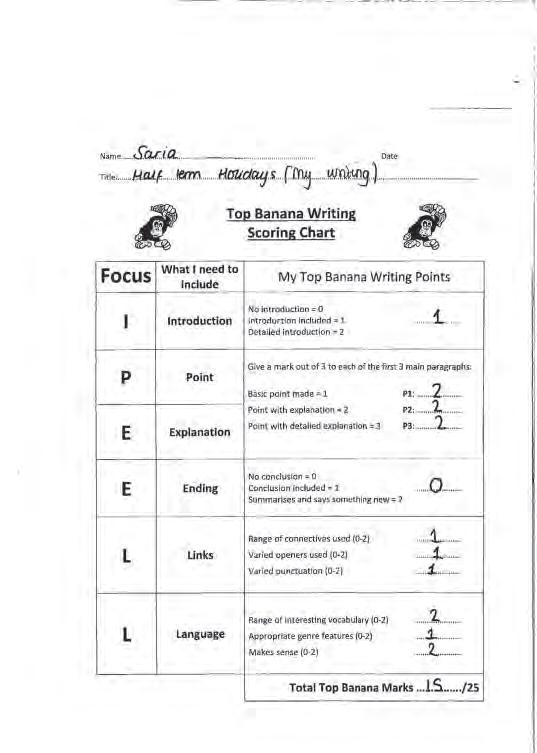
10 minute read
STAGE 3: Model it
Scoring the modelled writing
When the modelled writing task is completed, use the mark scheme created with the pupils in Stage 2 to score the final piece you have modelled. When you do this with them, keep talking through each aspect of the marking strategy. Your self-dialogue is likely to be something like this: “Did I include a clear introductory paragraph with additional information about the topic?” “Yes, I think it covered that aspect very well so I’m awarding myself two marks” “Did it engage the reader?” “I think it was rather matter of fact. I could have used better techniques to engage the reader. Perhaps a rhetorical question would have been a good idea to get the reader hooked into what was to follow. So I’m afraid I get no marks for that aspect.”
Goal setting
When the modelled piece has been marked, discuss with the pupils the aspects that could have been improved by focusing on those elements with the lowest scores. Decide which of these would be the main focus for improvement in the next piece of writing. These aspects then become the goals for improvement and are recorded on the mark sheet.
Scoring the initial task
It is now time to return to the initial task, which was carried out after the introduction to the text type. Ask the pupils to score their own piece of writing using the agreed marking scheme. It is useful to ask one of the pupils to volunteer to share their marking with the class and to seek agreement on the accuracy of the assessment. Initially, pupils tend to be generous with their scores but, as they become more proficient using the technique, they can be quite hard on themselves. This is where additional teacher assessment of the same piece is used to corroborate their scores.



Chart it
When the pupils have marked their initial piece and recorded their scores on the marking sheet, they will have a numerical total for the writing. This is the baseline score against which future pieces will be compared. Pupils should now be introduced to the recording sheet where they can enter the marks scored under each section and then record their results on the chart. Although this may seem to be a diversion from the writing process, it is a very important part of the strategy. It is especially important for those pupils who find writing difficult but who are visual learners and are good at working with charts and diagrams. Boys, in particular, respond to this aspect of the strategy very positively and are keen to chart their next piece of writing and to measure their improvement. Initial time spent in preparing the recording sheets will pay off in the long term as it is important not to spend too long in drawing charts but simply to record scores. A separate recording sheet for each text type is important as the comparison needs to be like-for-like. It is expected that pupils will show improvement with teaching and practice in a specific text type and the shading on the chart should reflect this. Any change to a new text type might result in lower scores and this would not have the same positive effect on motivation. The recording sheet should also have a section where pupils can set themselves a goal or goals to improve their next piece of writing. A similar section where teachers can add comments is also an essential feature of the recording sheet.
My goals
Teacher comments
I need to include more detail with each point Also think about persuasive techniques
The IPEELL recording sheet template may be downloaded and reproduced for classroom use from the National Literacy Trust website, Improving Writing at Key Stage 2 Participants’ area.
Having completed the marking and recording sheets, and set the baseline, it is time to move on to the next writing task in the same text type.
IPEELL
Stage 4: Memorise it


›› Use different activities to help pupils memorise PAT and IPEELL
Memorise it
For many pupils, using the mnemonics and key features of the strategy regularly will be enough to commit them to memory. However, there will be pupils who will need additional help, and this section outlines some of the techniques that can be used. It is certainly not an exhaustive list and teachers will develop their own practices that work best with their pupils.
Revision practices
■ Starting lessons with quick recall activities is a useful technique for reinforcing the meaning of each letter in the mnemonic, such as: “Write down the mnemonic” or “What does the first L stand for?” ■ “What words beginning with E could help you when writing?” ■ “Write out PAT and IPEELL in books or on paper and state what each letter stands for.”
Cut and paste activities
■ Pupils who need additional practice can gain from using cut and paste activities where they are given the mnemonic and its component parts in a jumbled list.
They then have to cut them into strips, rearrange them in the correct order and stick them in their exercise books.
Games
■ Partners test each other on their knowledge. For example:
“What does PAT stand for?”
“What are the five Ps in narrative writing?”
“Give me three sentence openers for persuasive writing.”
“List six different conjunctions.” ■ Pass the ball type games: Pupils receiving the ball have to provide the next meaning, feature, etc.
Use sign language
In one school that had special provision for hearing-impaired pupils, they used British Sign Language as a learning aid. The signs were later adopted by all children as a practical way of remembering the parts of the strategy. In other schools, children invented their own signs and gestures and used these when reciting the mnemonic.
Rapping, rhymes and songs

Some children enjoy making up raps, rhymes or songs and these can be used to help pupils become more familiar with the strategy. To the tune of Frère Jacques, try: Introduction, introduction Points explain, points explain Ending, links and language Ending, links and language That’s IPEELL, that’s IPEELL
Quizzes

Quick-fire question-and-answer sessions help embed the different features.
Displays and working walls

IPEELL lends itself brilliantly to high-quality displays that help pupils memorise the important parts of the strategy. The mnemonic remains constant for all text types and is therefore a good basis for a working wall. A good example of this is illustrated on page 66.
Lending a hand for narrative
The hand is a simple aid for memorising the five Ps for narrative:
Period
People Problem/panic
The 5 Ps
Peace
Top Banana Writing
The mnemonic IPEELL is used because it fits closely with the teaching strategies already being used in the teaching of writing as part of the National Curriculum. During a training course with subject leaders, one teacher exclaimed, “It’s like peeling a banana and unwrapping the secrets of writing.” From that point onwards, the strategy became known in many schools as ‘Top Banana Writing’. The title immediately appealed to primary pupils and many displays in schools started to reflect the new name. Mark sheets changed to ‘top banana scorecards’ and recording sheets became ‘top banana score charts’. In some schools, bananas were regularly used as rewards. At one of them, the endof-week reward for top-quality writing was a banana-based treat like a banana split or banana milkshake. Needless to say, these went down particularly well with pupils. Through repeated use and a variety of quick writing activities, pupils soon become familiar with the mnemonics and key features.

IPEELL
Stage 5: Support it
›› Pupils produce their own self-instruction plan checklist
›› Extend writing by providing more detailed models and more detailed scoring

›› Introduce peer review and scoring

›› Refine goal setting
›› Fade and eventually remove the planning frames
›› Keep going until the strategy is embedded
Support it
Having introduced the different features of the strategy to pupils, this is the stage where the real development of the text type takes place. Pupils should now be aware of the purpose, audience and type (PAT) of writing they are working on. They know about the mnemonic IPEELL and have used planning frames to organise their ideas. They have marked their own writing and attempted to set goals for improvement. Now is the time to focus on developing writing skills and techniques through frequent quick writes with the emphasis on quality not quantity.
Model writing using a self-instruction checklist
Before attempting the next piece of writing, remind pupils about the importance of self-talk and what they need to concentrate on before, during and after writing. It is useful at this point to model ‘think-alouds’ for each stage of the writing process. “What do I need to ask myself before I start writing? P – What is the purpose of this piece of writing? A – Who will read it? T – What is the best format for this task? “What do I need to remind myself of while I am writing? Plan first Follow the IPEELL structure Use appropriate links and language features Think about my motivational message: ‘Keep going. I can do this!’ “What do I need to do when I have finished writing? Have I written enough in each paragraph? Does it make sense? Is it linked together sensibly and does the ending wrap it all up properly?” The pupils should now use this model to construct their own self-instruction checklist. The focus on self-instruction will support the pupils as they begin to plan, as well as while they are writing, and when they return to their writing for editing.
Extending pupils’ writing
By constantly providing more detailed models of a specific text type and highlighting how the author has achieved the purpose, pupils can be introduced to different writing techniques. It is important to build up in stages by working on different aspects of each writing task. This doesn’t need to result in a complete or extended piece of writing every time. The task can be broken down into parts and emphasis placed on each section. “What makes a good introduction?” or “How can we engage the reader?” A whole lesson could be devoted to developing a good introduction or ending. These shorter pieces of writing can still be scored against the agreed criteria. The marks can be recorded on the mark sheet and added to when the next sections are completed. Every completed writing task should be scored and recorded on each pupil’s recording sheet with goals set for improvement. For some pupils, this aspect of recording their progress is very motivating as they can see their improvement mapped visually. For others, it can be a distraction, and teachers will need to use their discretion when fading out the charting process. Just as not every piece of writing needs to be an extended piece, not every piece of writing should be regarded as finished once the processes of marking and scoring have been completed. The scoring and goals will provide children with specific detail of how the writing could be developed further, and can form the basis of editing and redrafting. For work to be considered ‘independent’, pupils need to have formulated the marking criteria and set their own goals for improvement. Children are then able to edit and redraft their writing to increase its effectiveness for the defined purpose and audience.








